
LINCS Context Explorer
I led the design of the LINCS Context Explorer tool, a web extension plugin that enables users to contextualize web content with cultural data drawn from the LINCS datastore.
As the sole UX designer on this project, I drove the design of the tool from a proof-of-concept to an MVP, helping secure a $200,000 partnership grant with Library and Archives Canada.
Context
LINCS is a grant-funded interdisciplinary project creating linked data tools that enable researchers to create and share cultural data.
Previous usability tests on other tools found that casual users (such as undergraduate students) had difficulty understanding and finding value in our data. When presented with a large list of data entities and complex metadata terms, users had trouble making meaning out of the information.
At its core, linked open data allows data owners to contribute to an interconnected body of knowledge on the web. With this in mind, how can we enable users without knowledge of linked open data to access this body of knowledge?
Our solution was the LINCS Context Explorer — a chrome extension that lets users explore connections between people, places, and works directly on a webpage. In this project, alongside a project lead and three developers, I designed the overall flow and interface to enable users of all skills to access LINCS data and create new understandings of cultural data.
My impact
Collaborated across a cross-functional team, shaping feature development through user-centred practices.
Designed the end-to-end interactions and interface for the Context Explorer.
Initiated and conducted usability testing, enabling the team to evaluate designs and prioritize feature development.
Supported content development, allowing casual users to understand and make use of LINCS data.
What it does
Using named entity recognition, users can scan a web page connecting named entities found in the web page to data points (otherwise known as ‘entities’) found within LINCS, including people, organizations, places, and artistic works. From there, users can explore entities' relationships and learn how they’re connected through an overlayed node-edge graph and an informational side panel.
Using this information, academic researchers and people interested in cultural knowledge can discover new connections and relationships.


Initiating the project
The project first began as a proof-of-concept, developed in Summer 2021. As a part of LINCS' official launch in April 2023, we sought to build an MVP version of the tool. As the sole designer on this project, my task was to guide the direction of the experience, in addition to designing the interface.

To initiate the design process, I first conducted a stakeholder meeting to establish the project's goals and requirements. In this meeting, I discussed usability issues found in existing LINCS tools, focusing on the issue of technical language. Past studies on previous tools, found that users with limited knowledge of linked data had difficulty creating value out of LINCS data due to the complexity of language. As such, research questions could not be answered and interesting discoveries could not be made.
With this in mind, we established some high-level use cases:
A scholar on a web page with unfamiliar references uses the extension to provide context for the information they are encountering. (e.g. someone interacting with a record on a library site)
A user reading an academic article uses it for finding contextual information about the scholars whose work is referenced.
Scholars navigate to LINCS-related materials, using the Context Explorer to contextualize what they find there.
Defining the users
Based on the requirements and outlined use cases, it was clear that we had to focus our tool for casual users. As defined from previous research, casual users comprise of academics, scholars, and the general public that have an interest in exploring cultural information with no knowledge of linked data. With a broad user profile, I opted to focus more on specific shared behaviours between these different users rather than creating individual personas.
Using pre-existing user stories and data gathered from previous user research, I outlined behaviours relevant to accessing linked data which, in turn might affect the usage of the tool.
When researching a topic, users initially scan through a variety of resources to find relevant information.
As a result, users will quickly abandon a resource if they don't find it useful.
Academics and students often only commit to learning and using a tool when it's critical to a project
Since the context explorer is a tool for accessing data, it most likely will not be a critical tool for academic projects. Therefore, users may not take time to learn the tool.
Users will have varying research goals that have different degrees of complexity and specificity.
Information provided by the context explorer needs to be relevant to a broad set of research contexts.
Establishing design goals
The main goal I wanted to accomplish with the design was to guide the user to information they value and understand. This included:
Provide a clear and simple workflow.
Accessing data that provides informational value isn’t always apparent in linked open data; as such, I wanted users to be able to reach important information without a long onboarding period.
Using familiar language and categories of information.
The data model used by LINCS is particular and complex — to help users better understand the context of the information, I wanted to use familiar language to frame the information users would receive.
Designing a clear user flow
To strategize the experience I wanted to create, I outlined a high-level user flow that focused on three stages: scanning, matching, and exploring.
During this process, I conducted two usability tests to validate and iterate on my designs.

Scanning
While designing this stage, a significant part of the effort went into the microinteraction. To initiate my designs, I first began ideating on various ways to initiate a scan and select a scanned and highlighted word.
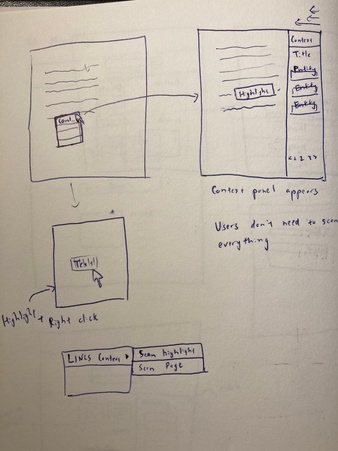
different approaches to initiating a scan
Through initial discussion with the team, we decided that users would hover to view the word's LINCS matches. However, in my initial usability test, I found that all participants continuously attempted to click on highlighted words, causing issues when the word was a hyperlink.
Another challenge was that we couldn't just change the interaction to a click, as we didn't want highlights to disable a webpage's hyperlink functionality. Therefore, I found a compromise between clicking vs. hovering. I modified the interaction to display a clickable selection button over the highlight on hover , to hopefully instill a behaviour for hovering first.
To discover if this worked, I ran a new usability test to find out whether participants could learn to not click the highlight. From a small sample group, I found that 3/10 users were able to either discover the interaction on their first try or recover from their error on a subsequent attempt. Although not an ideal number, it was still an improvement from the previous result.

Matching
After users select a highlight, they then are presented with a list of matches that are found within LINCS data. LINCS has over 50,000 entities, all with varying degrees of information — as such, one important aspect was to assist users into selecting results that had potential information value. As such, I came up with an indicator that displayed the number of connections. Results with higher counts would often have greater information value over results with lesser counts.
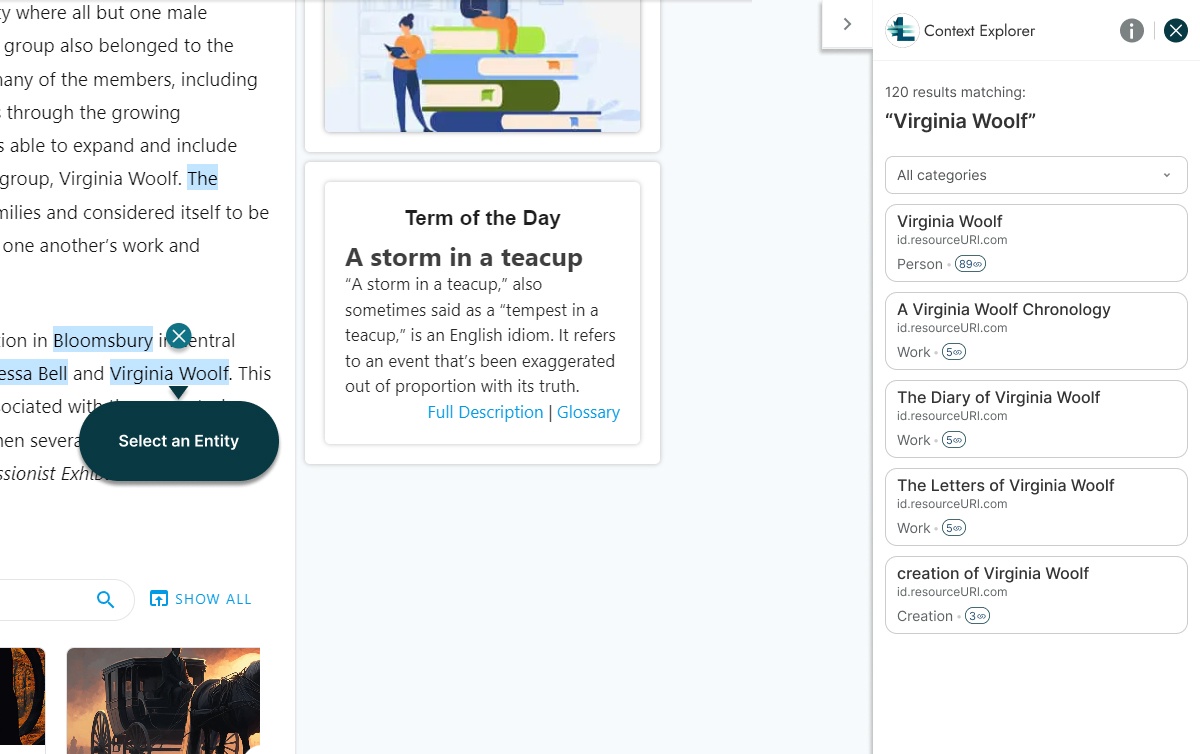
Exploration
In this stage, we wanted to display what relationships our matched entities had with other LINCS entities. A key part of designing this stage was determining how to represent this relationship visually. Initially, the proof-of-concept contained all interactions and information within a node-edge graph, causing issues with understandability due to a lack of visual differentiation. In addition, I knew that only containing a graph could create challenges for screen-reader accessibility. To address this, I created parallel representations through both an overlayed node-edge graph and a new side panel.
First, I looked to redesign the graph, sketching out ideas that focused on better clarity of system state to indicate what entity the user is currently exploring. By placing selected entities in a central pill, users would have a better idea of what relationship they're analyzing.
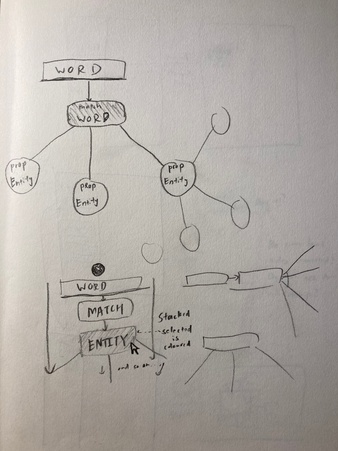
thinking about how to display information via nodes.

From there, I began work on designing the side panel. To communicate a relationship between two entities, and their resulting relations, I divided the panel into those respective sections, to establish consistency with the graph. To display the relationship between entities, I iterated on various nested designs.
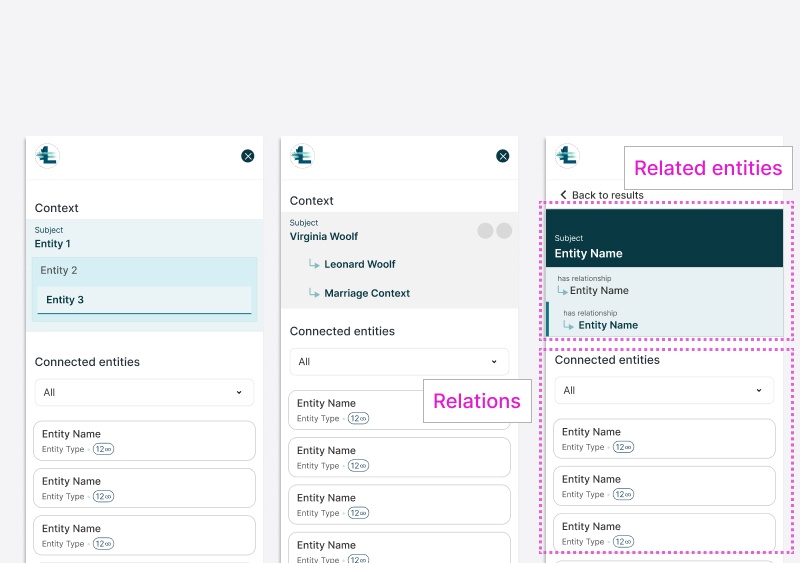
After multiple rounds of design feedback and content revisions, we decided on the design below. In the first usability test, I found that all 5 participants understood the visual format, being able to identify the entities' relationship and relations.
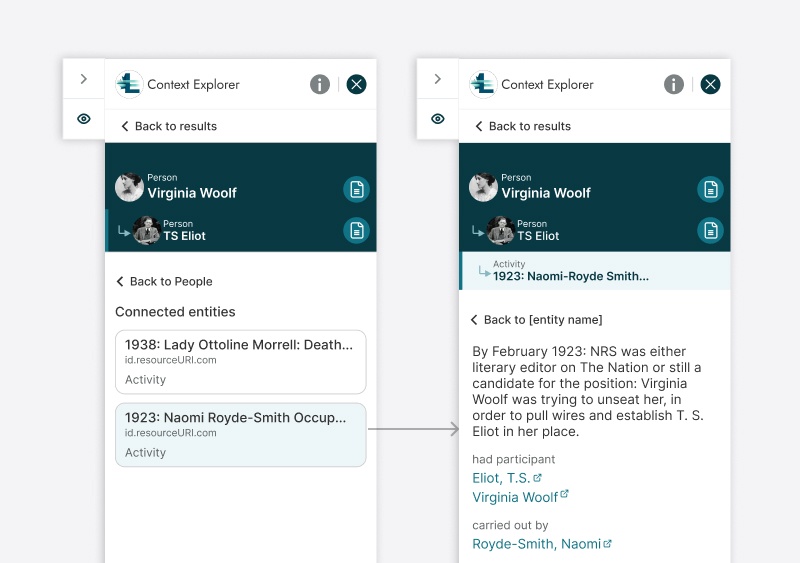
Working with data and content
I had the opportunity to design the content as well. The side panel contained a dropdown that information specific to a selected entity. However, usability tests found that participants didn't understand this information, causing them to ignore the section.
Thus, I helped created a more informative summary section for the side panel dropdown. By auditing existing datasets in LINCS, I identified common data points represented in LINCS entity types (i.e categories like people, places, and works) to create a summary framework.
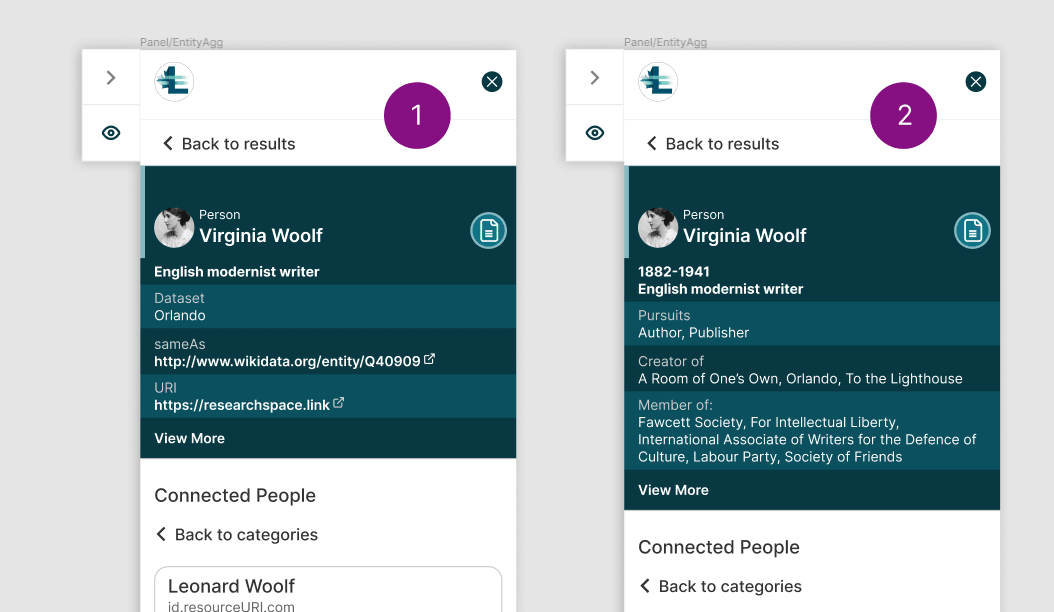
Current Design
Final thoughts
Thanks to the hard work of the team, the Context Explorer was presented and featured at various academic conferences. At Congress 2023 of the Humanities and Social Sciences, as part of the Canadian Society for Digital Humanities, I held a demo session and at Making Links 2023, was also a part of a UX panel discussion talking about the tool.
This was one of the first projects where I had the opportunity to take ownership of the design to development. Throughout this process, I learned a ton about communicating with developers, from handing off designs, understanding how interface components are created, and how data is used.